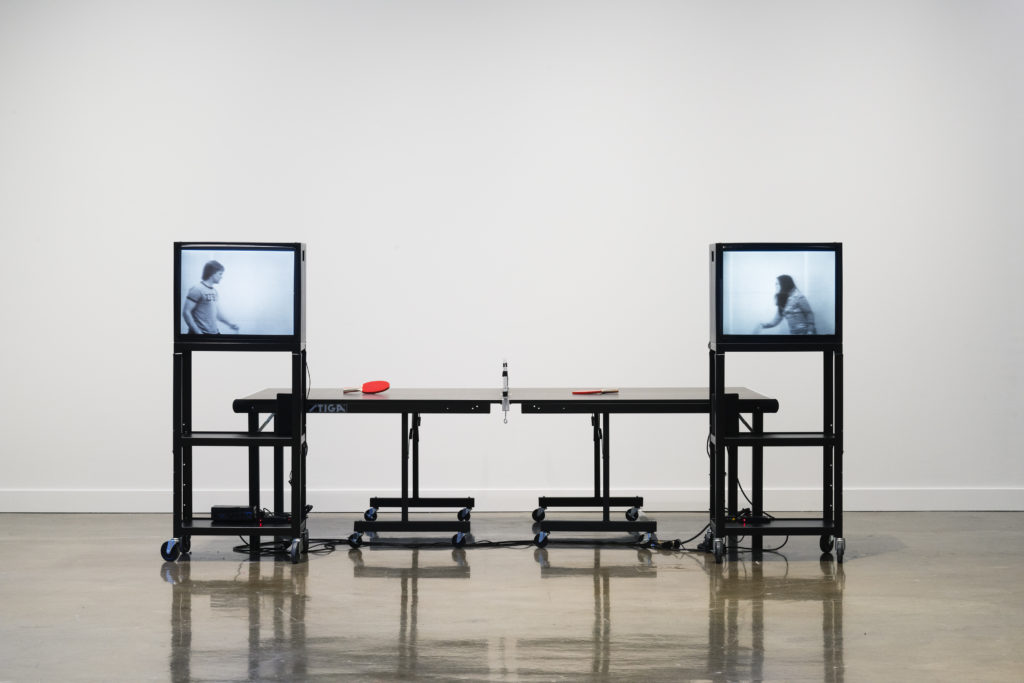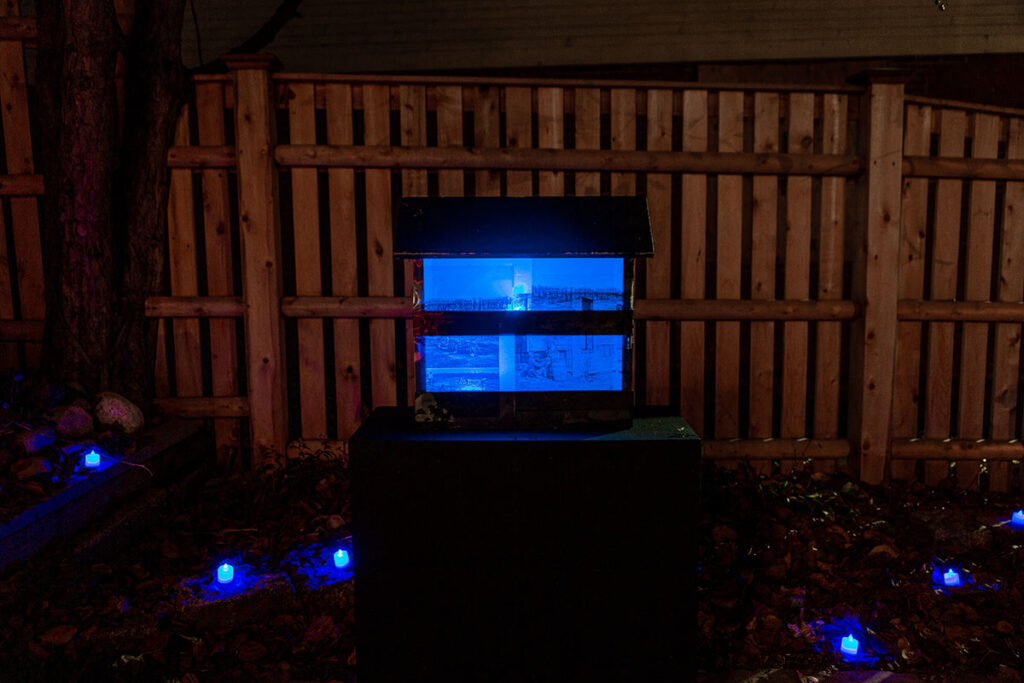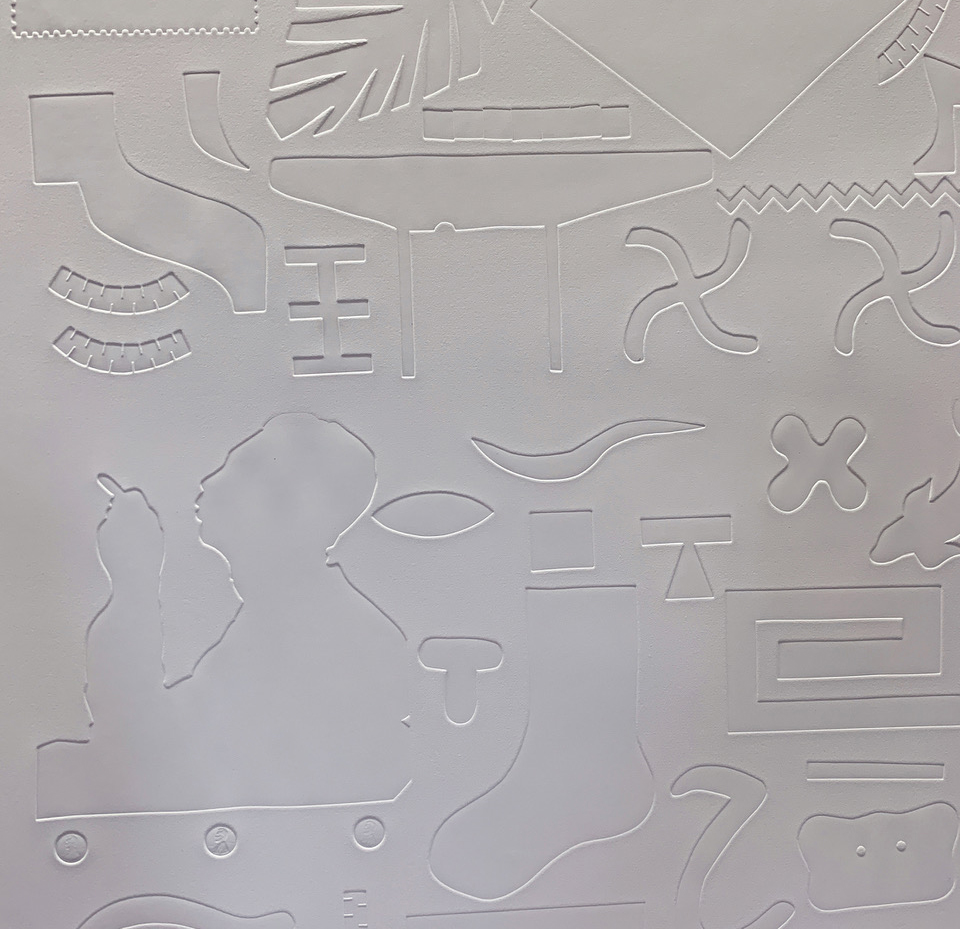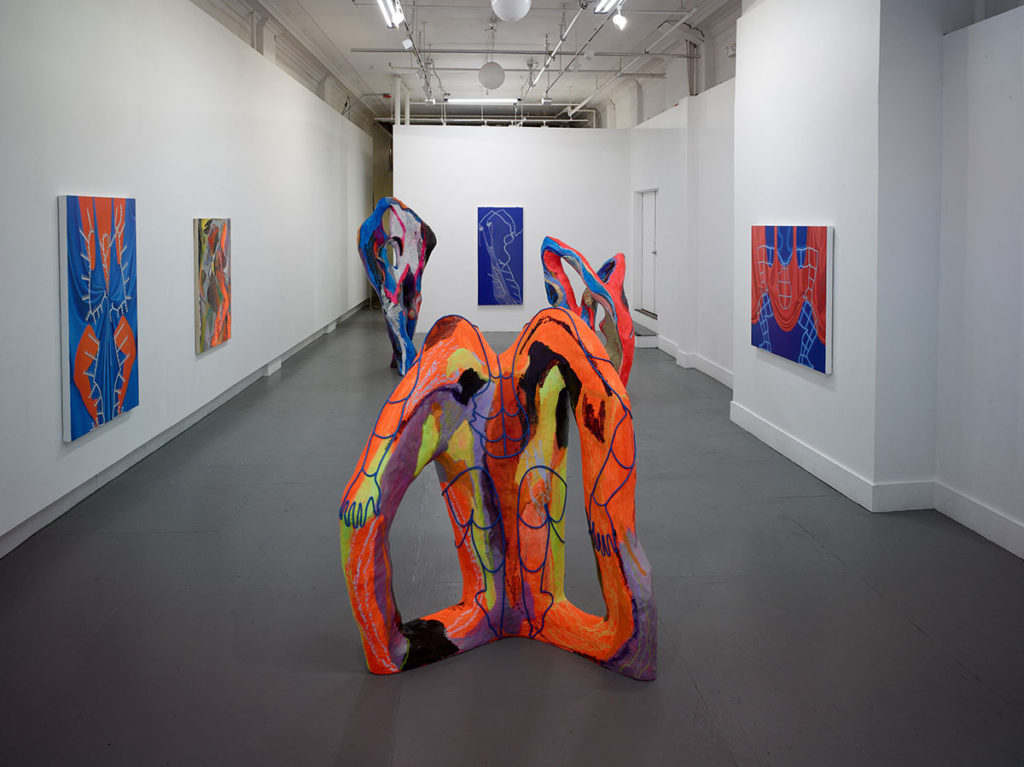by Joshua Reiman
Before Projection: Video Sculpture 1974–1995 brings the presence of video art and its original device of the television monitor into play with the real material of sculpture: space. Early video work is not often seen displayed in art spaces and institutions. It is mostly available through Electronic Arts Intermix, on YouTube, Vimeo, UbuWeb, or one may have come across it in art history classes, as a single image online, or in books. The monitor work in this exhibition helps set the stage for immersive video projections that we see readily available in many institutions today. This smart grouping of artists (mostly women) and the almost disparate themes throughout the exhibition coalesce together as a meaningful array of historical markers for what video sculpture looked like at a very important time in a contemporary art format from a not-so-distant past. This exhibition reminds us where video has come from and allows us to question where it is now.
Flat monitors and HDTVs are the new normal, easily accessible, all of which allow us to see video as a picture plane: flat and bright, Retina and digital. This new aesthetic bombards us like big box store showrooms selling gaming, sports, or news entertainment, reminiscent of what Guy Debord aptly named the “Society of the Spectacle.” This exhibition, however, breaks from today’s standards and guides us towards looking at video by slowing down to contemplate image in space through monitors that are from a different era of consumerism and technology. The “cube” monitors of the past, like Sony Trinitrons and Hantarex, and contemporary analogs, such as Dotronix, allow us to see video as sculpture through scale and volume, but also as a specific quality of image.
For younger artists and audiences, it may offer up time to see what physicality looks like through the presence of video monitors, stacked and arranged purposefully to display content. Museum-quality projectors, with their high-costs, are often very much out of reach for young video artists today who seek high quality images. This exhibition, on the other hand, is a remarkable display of analog technology. Upon further investigation into what drives this exhibition, I noticed that many of the videos were playing from brand new ultra compact digital media players. Many of the monitors in the show are new Dotronix monitors, which were not available for the work in their original renditions. It goes to show that as technology changes — and the means for display become outdated, obsolete, or difficult to maintain — some institutions and artists adapt in order to keep the message of the medium as close to the original as possible. Where artists are sticking to the puristic forms of deploying their media, institutions are challenged to adjust technology to best suit the needs of the work. This happens flawlessly in Before Projection, where the arrangements of monitors act as architectural elements within the galleries of the List Center.
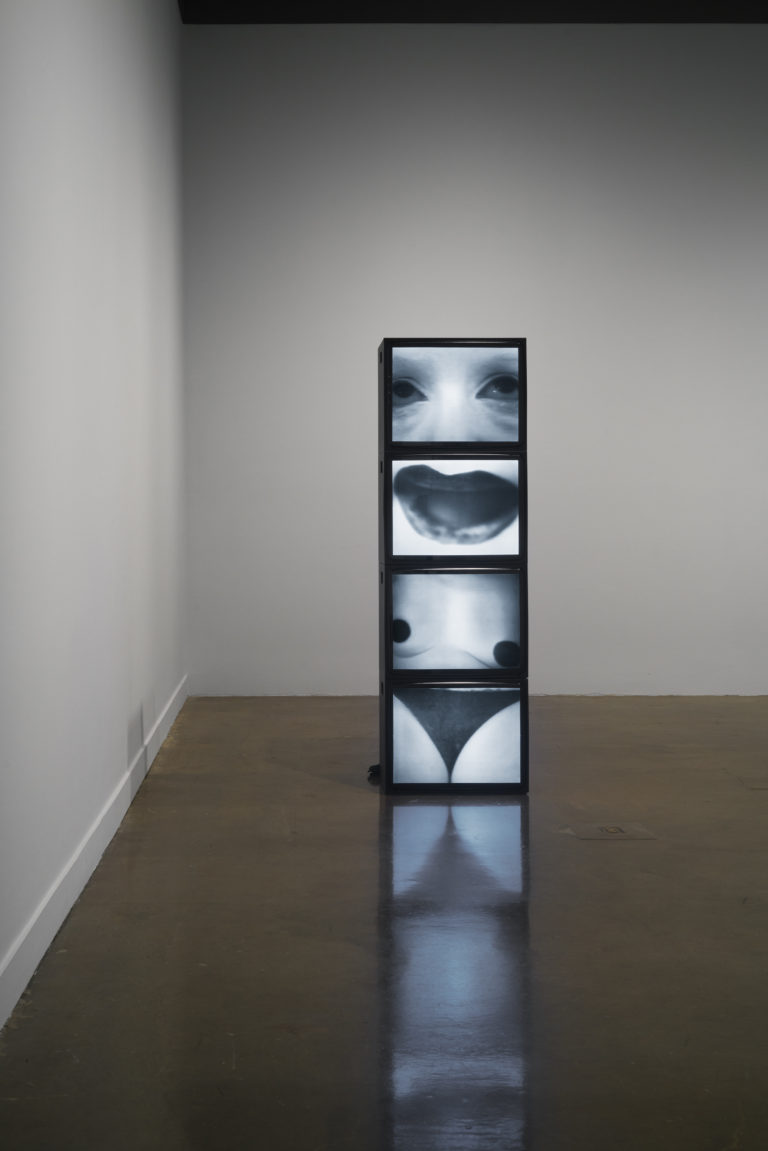
Four digitized videos with sound, 10:00 min. each. Dimensions variable. Courtesy Hamburger Kunsthalle, Hamburg. Photo: Peter Harris Studio. Exhibition installation view of Before Projection: Video Sculpture 1974–1995 at MIT List Visual Arts Center, Cambridge, MA (February 8–April 15, 2018).
Upon entering the exhibition, one is confronted with Friederike Pezold’s four-channel video sculpture Die neue leibhaftige Zeichensprache (The New Embodied Sign Language) (1973–76). The scale of the four stacked monitors mimics the body, yet the body is not as we normally see it. Only fragmented skin and enlarged portions of the face make up a new body — a minimal, video body. I loved that the piece was in the middle of the room, allowing for a phenomenological experience with sculpture. This totemic form is not only meant to be viewed from the screen side. It is important, as viewers, to able to walk around it to see the cords and monitor boxes: the back, sides, and the front. The video body as a whole needs to be seen so we know what the body is made of and recognize it as a sculptural body in space.
Ernst Caramelle’s Video Ping-Pong (1974) is a perfect example of how video can replace the real with the imagined. Monitors are positioned at the perfect height for human scale, replacing the body as object. Caramelle is an important German artist who has spent a long career making work about perception, and deserves a thoughtful look from American audiences who have not been exposed to his massive portfolio of mural-sized paintings or video art. His paintings require our eyes to work out spatial relations through color theory and distance, informed by a combination of conceptual underpinnings from Joseph Albers, Sol Lewitt, and Walter De Maria. Caramelle achieves this through layering geometric shapes in architecture —often with washed-out colors demarcating the forms — that offer planar and volumetric compositions that mess with your depth of field. Caramelle is not a household name for his early video work, but he should be: Video Ping-Pong is a showstopper. In other video works, Caramelle often replaces the human body, tools working, or parts of plants, with a video monitor portraying the exact same image (body, tool, plant) in front of the object, expanding the space of object relations and depth of field. Video Ping-Pong acts much like looking at a fireplace and getting lost in the flames: one can watch this piece and get lost in its cadence and physical presence.
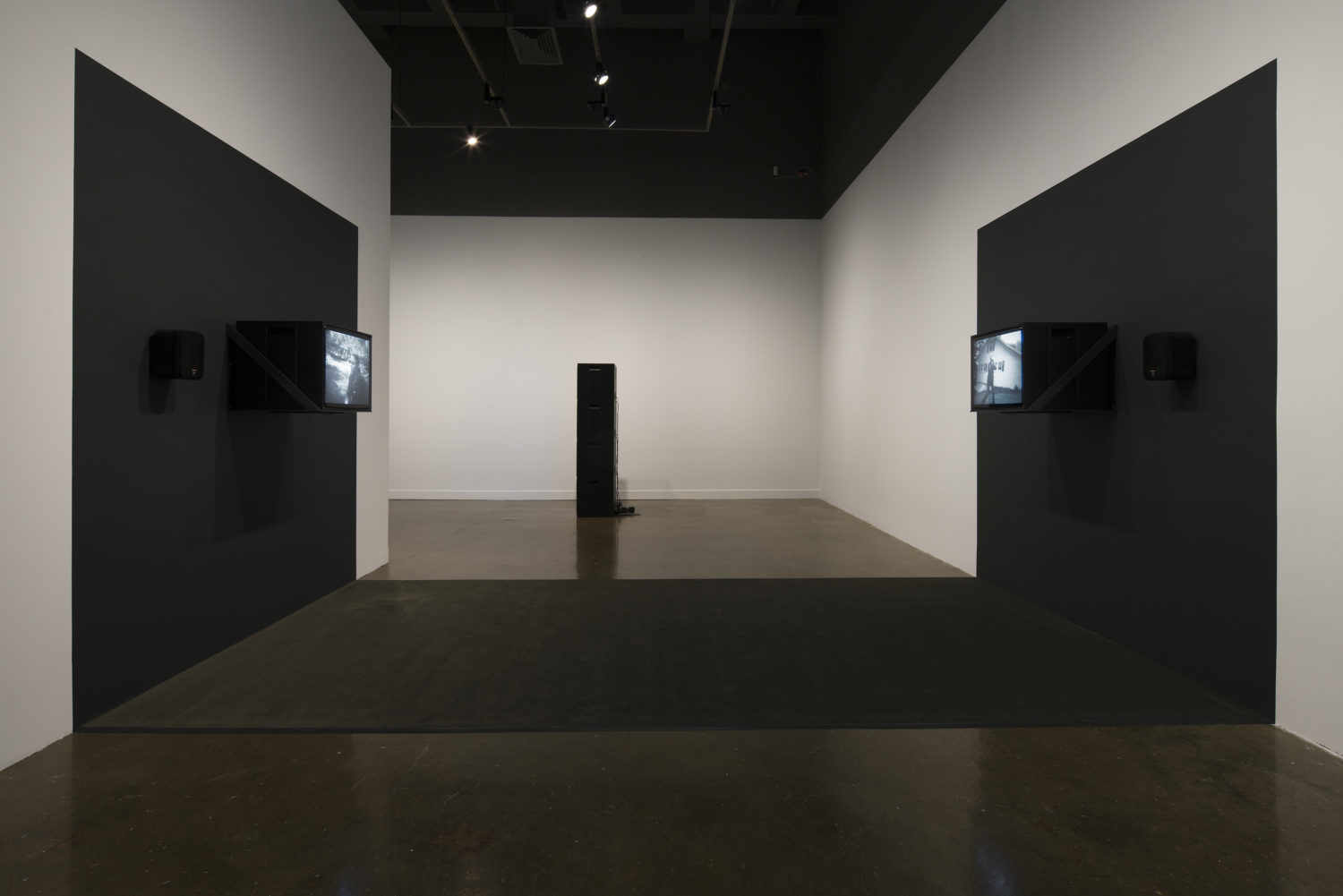
Two-channel video (transferred from foriginal Super 8 film footage and 35-mm slides) with two-channel mono-mix sound, black-and-white, 7:40 min. Dimentions variable. Courtesy the artist and Marian Goodman Gallery, New York/Paris/London. Photo: Peter Harris Studio. Exhibition installation view of Before Projection: Video Sculpture 1974–1995 at MIT List Visual Arts Center, Cambridge, MA (February 8–April 15).
Dara Birnbaum’s Attack Piece (1975) places the viewer in a space where one can never really see the whole piece when inside it. A slide show and Super 8 footage play on monitors in a cordoned-off space of black walls and black carpet. This piece traps its viewers as if being hit from all sides, bombarded with sound and image in which the camera is a weapon and positioning is questioned. I wondered how the people in the video are seen in today’s societal climate: is a woman wielding a camera, much like a gun, seen as a feminist action? Or does its nostalgic format obscure this for younger audiences? All of the people trying to enter Birnbaum’s space in Attack Piece are men with cameras (who happen to be artists Dan Graham, Ian Murray, and David Askevold). This “attack” is gendered and recalls many poignant issues which remind us that, as of today, male aggression toward women still has not changed. Video, however, is now a weapon more than ever! Birnbaum seems to conjure the future here (the present — 2018) by offering a perspective of what it looks like when under attack from all sides to all viewers, both to those who have not experienced anything like this, and for those who have dealt with this unfortunate position. The installation doubles down on this “attack” through perception by placing us in the middle of the conflict.
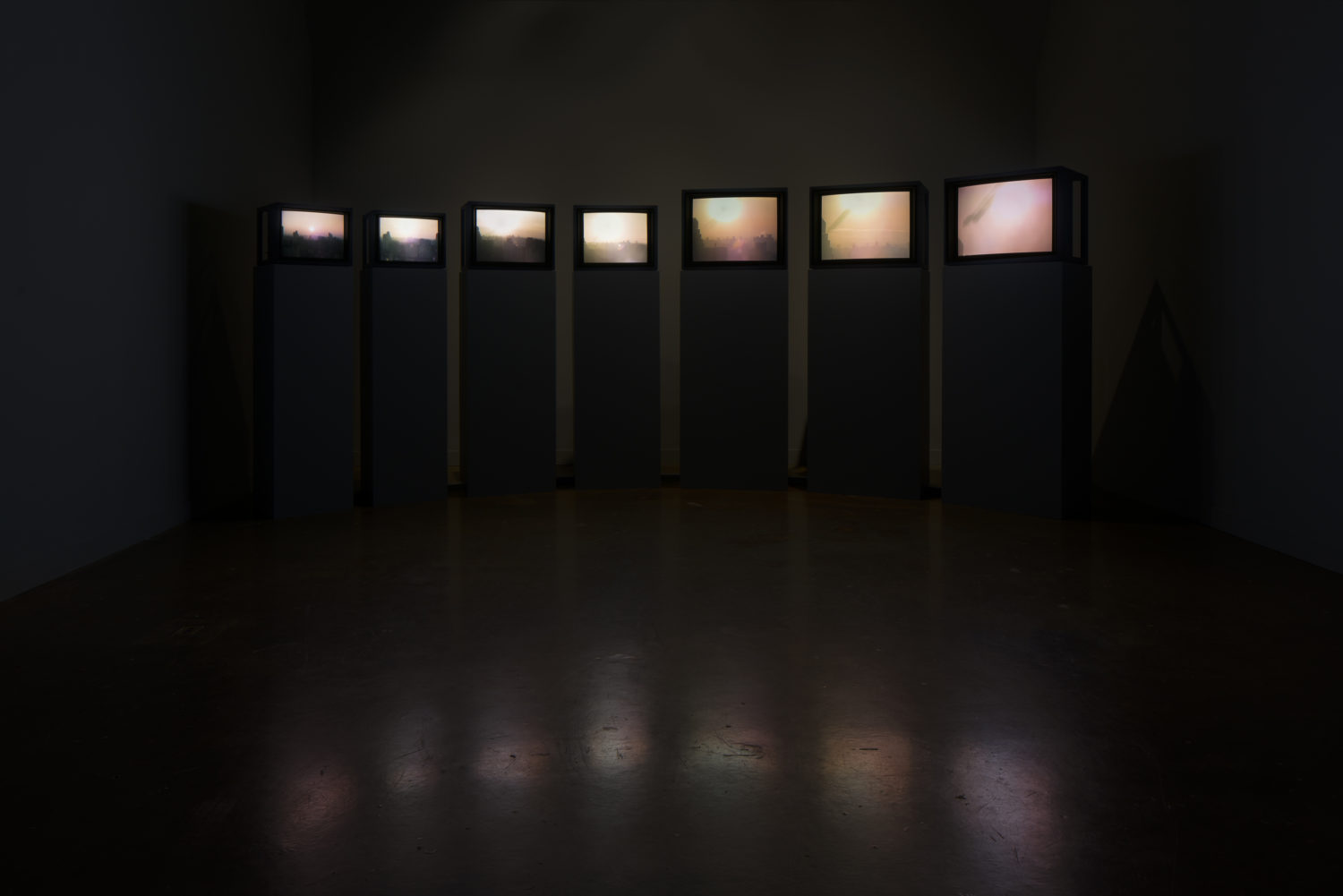
Seven-channel video installation with sound, 33:00 min. 17 ft, 8 × 68 × 94 ¼ in. (539 × 173 × 239 cm). Courtesy the artist and Lennon, Weinberg, Inc., New York. Photo: Peter Harris Studio. Exhibition installation view of Before Projection: Video Sculpture 1974–1995 at MIT.
Mary Lucier’s Equinox (1976/2016) is a meditative piece that consists of cube monitors of various sizes high up on pedestals. The monitors play a sunrise with the camera pointed right at the sun over Lower Manhattan. The piece is bigger that us, it looks down and simulates a repeated landscape that is expansive, while also breaking the rules of cinematography with purposeful lens flare. It is quite a conceptual work that needs time for the viewer to see the sun’s effect on the video sensor altering the image. Equinox challenges the medium. Lenses and sensors, tubes and light, directly change the media outcome by burning its capability in making a stable image and then displaying its flared outcome.
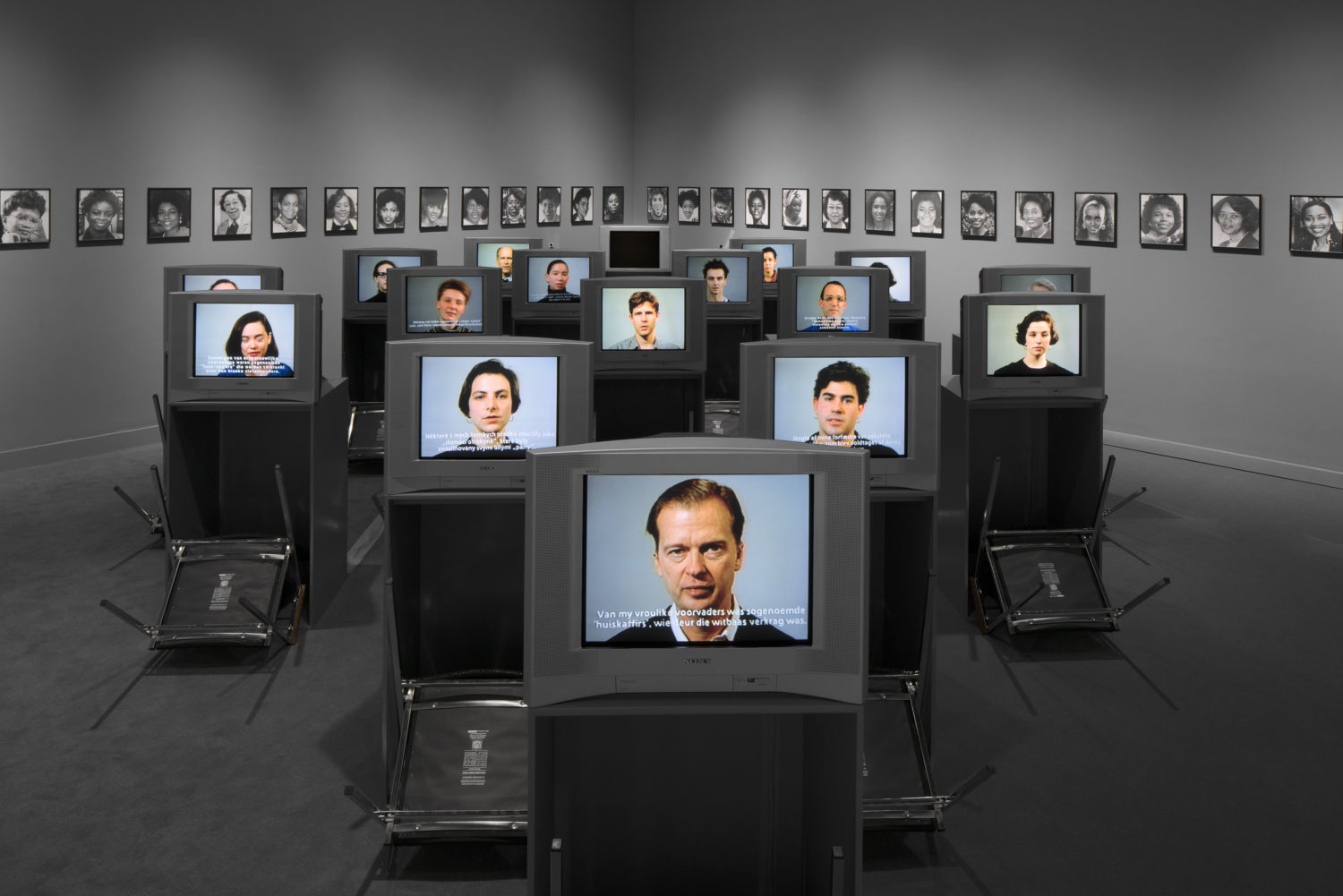
Seventeen-channel video installation with sound, 26:00 min., with seventeen monitors, sixteen pedestals, table, twenty-three chairs, and sixty-four gelatin silver prints. Dimensions variable. Courtesy the Whitney Museum of American Art, New York; Gift of the Peter Norton Family Foundation. Photo: Peter Harris Studio. Exhibition installation view of Before Projection: Video Sculpture 1974–1995 at MIT List Visual Arts Center, Cambridge, MA (February 8–April 15, 2018).
Adrian Piper’s Out of the Corner (1990) is the most expansive piece in the show. Its bluntness about slavery, blackness, and skin tone can take one’s breath away. Sixteen monitors with chairs overturned are arranged in front of a single monitor, placed in the corner with a table turned upside down in front of it. A line of sixty-four portraits of black women from different social backgrounds is displayed on the walls. The artist appears on the single monitor, discussing sexual relations between races. As Piper makes her point, other monitors turn on with white men and women on screen saying, “Some of my female ancestors were so-called ‘house niggers’ who were raped by their white slave masters. If you are an American, some of yours probably were too,” which is also displayed over their faces on screen. Piper’s frankness puts pressure on the audience who may be culpable of racism through their own histories and guilt. Out of the Corner is a calling card for Americans to understand that the foundation of this country was built on slavery. Today, when injustice can be seen and revolutions are started through camera phone footage and social media, video is now the medium that brings societal issues to the world. It is palpable in this piece. Piper is one of the most important political juggernauts in the contemporary art world. A comprehensive retrospective of her work is currently on view at MoMA through July.
Other artists represented in the exhibition are Takahiko limura, Shigeko Kubota, Muntadas, Tony Oursler, Nam June Paik, Maria Vedder, and Diana Thater. (Thater will christen the ICA Boston’s new offsite space, The Watershed, this summer.)
The flow of Before Projection reveals how being confronted with video as a physical format is an important physiological element within experiencing an artist’s conceptual intent. After the work is made, the way it is seen and experienced can often out-maneuver our perception of what was made. That is why this show is so important. Every piece in the show directs our attention to not just the content of the work, but also the visceral feeling of being in a space with moving image. The work and the curatorial decisions made in Before Projection make this a seminal exhibition within the field of early video art, specifically that the show defines “video sculpture.”
Great show, fabulous curation, and a shout out to the installation team that must have had their hands full with this many monitors and media players. This is no easy task to get working correctly. Some of the work displayed in this show is being exhibited over forty years after its inception. In technological years, that is a lifetime, from analog to digital and beyond. Through the lenses of Before Projection: Video Sculpture 1974–1995, we are able to see what the space of video sculpture looks like in a pre-digital era through some remarkable works.
Before Projection: Video Sculpture 1974–1995, curated by Henriette Huldisch, was on view at MIT List Visual Art Center from February 8 – April 15, 2018.
MIT List Visual Arts Center
20 Ames Street, Bldg. E15, Atrium level, Cambridge, Massachusetts | 617-253-4680
Open Tuesday–Wednesday 12–6pm, Thursday 12–8pm, Friday–Sunday, 12–6pm. Free.
Joshua Reiman is an artist living in Portland, ME, where he is an assistant professor of the MFA in Studio Art and chair of the Sculpture Program at the Maine College of Art.

